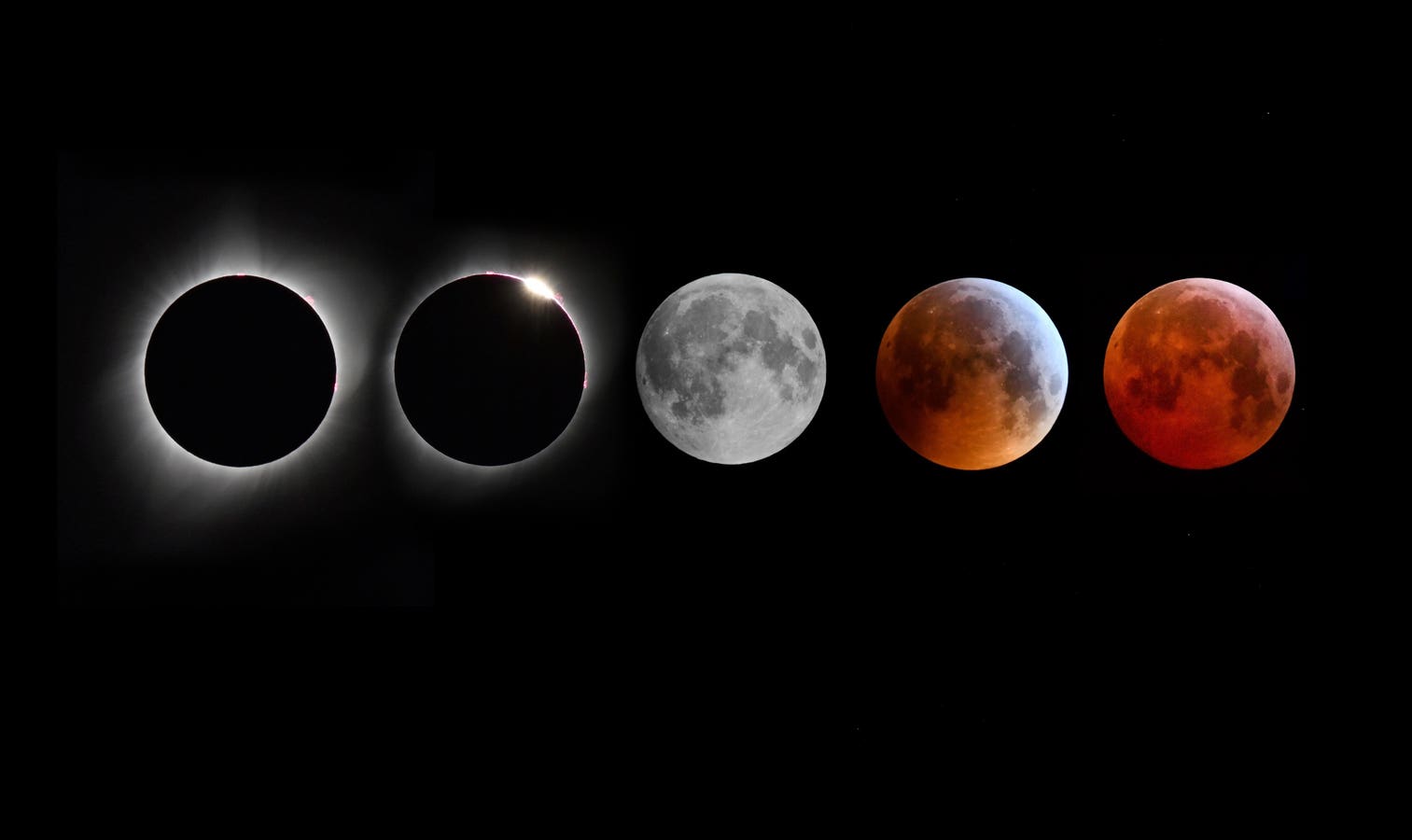A montage of moon images during a total solar eclipse and a lunar eclipse
getty
A total lunar eclipse — also known as a “Blood Moon” — is a rare celestial event coming this weekend. Since it occurs before moonrise, North Americans will see it only as a regular full moon appearing during dusk on Sunday, Sept. 7, 2025. Two weeks later, a solar eclipse, another rare occurrence, will take place.
Do you know the difference, what causes them and why they come in pairs? Here’s everything you need to know about the difference between a lunar and a solar eclipse — and when the next eclipses are.
What Is A Lunar Eclipse?
A lunar eclipse occurs when the Earth is directly between the sun and the moon. That is only possible during a full moon. Normally, this is when the sun fully illuminates the whole of the moon, and we see it rise in the east and set in the west, all the while fully illuminated. However, a couple of times each year, the rough alignment of sun-Earth-moon becomes exact, and the moon travels through Earth’s dark shadow in space. This is a lunar eclipse, when Earth’s shadow darkens the moon. There are three types of lunar eclipse:
- Total Lunar Eclipse: The moon passes through Earth’s umbra (its dark inner shadow) and its surface glows a coppery-red color as sunlight filters through Earth’s atmosphere — that’s the “blood moon” (though it’s never blood-red).
- Partial Lunar Eclipse: Only part of the moon is covered by Earth’s umbra. To see the edge of Earth’s curved shadow move across the lunar surface is very special, but there’s almost no color change.
- Penumbral Lunar Eclipse: The moon travels through Earth’s faint outer shadow, its penumbra, causing only subtle dimming. It’s a very subtle sight.
Some lunar eclipses are merely penumbral, or partial. However, a partial lunar eclipse includes a penumbral phase, and a total lunar eclipse includes a partial and a penumbral phase. This makes them long events, with Sunday’s event lasting 5 hours 27 minutes in total, though the “blood moon” part — totality — will last 1 hour and 22 minutes.
Unlike solar eclipses, all lunar eclipses are completely safe to view at all times with the naked eye, binoculars and telescopes.
When Are The Next Lunar Eclipses?
The second total lunar eclipse of 2025 will occur on September 7-8, and will be best seen from Asia, Africa and eastern Europe. The next one after that will occur on March 2-3, 2026, when an 82-minute “blood moon” will be seen from western North America, Australia and East Asia.
What Is A Solar Eclipse?
A solar eclipse is completely different from a lunar eclipse. It happens when the moon passes directly between the Earth and the sun, blocking sunlight from reaching Earth for a short time. It can therefore only occur at the new moon, a phase when the moon is roughly in front of the sun. However, the alignment has to be precise. It can only happen at all because the moon is almost exactly the same apparent size in the sky as the sun. That’s because the moon is roughly 400 times smaller than the sun, but about 400 times closer — though that’s not always the case because the moon has a slightly elliptical orbit. There are three main kinds of solar eclipses:
- Total Solar Eclipse: The moon completely covers the sun, bringing darkness in the day for a few minutes. During this totality, observers standing within a narrow path of totality can see the sun’s outer atmosphere, known as the corona, with the naked eye.
- Partial Solar Eclipse: The moon crosses only part of the sun. These are more common and can be seen over a wider area, and at no point can they be viewed with the naked eye.
- Annular Solar Eclipse: When the moon is slightly farther from Earth and appears slightly smaller than the sun’s apparent size, it doesn’t cover the sun completely. Instead, a bright “ring of fire” can be seen around the dark lunar disk.
Since looking directly at the sun can cause permanent eye damage, it’s crucial to wear eclipse glasses or solar filters at all stages of a partial and annular eclipse. Only during totality — which lasts just a few minutes or even seconds — can solar eclipse glasses be safely removed.
When Are The Next Solar Eclipses?
Some skywatchers will see 2025’s second partial solar eclipse on Sept. 21 over New Zealand, Antarctica and the western South Pacific. Up to 94% of the sun will be covered by the moon, making for a dramatic sight at sunrise. The next annular solar eclipse is on Feb. 17, 2026 (in Antarctica), and the total solar eclipse is on Aug. 12, 2026, in Greenland, Iceland and Spain.
Why Eclipses Don’t Happen Every Month
If there’s a new moon and a full moon every month, why don’t they create a solar and a lunar eclipse every month? It’s all down to the tilt of the moon’s orbit. The sun’s path through the daytime sky is called the ecliptic (there’s a clue in the name!). The moon’s orbital path is tilted with respect to the ecliptic, only by about five degrees, but that’s enough to keep the moon away from the sun most of the time. However, the moon’s orbital path crosses the ecliptic twice each orbit. It usually occurs when the sun isn’t at that point. So, most of the time, the moon passes slightly above or below the sun or Earth’s shadow, preventing an eclipse.
Eclipses only occur when the moon crosses the orbital plane at two specific points called nodes. When this alignment coincides with a new moon, we get a solar eclipse; when it aligns with a full moon, we see a lunar eclipse. This is why eclipses often come in pairs, spaced about two weeks apart.
Wishing you clear skies and wide eyes.









